Renault Sport F1 has released some very interesting information about its new electrified V6 turbo engine to be introduced in Formula 1 in 2014 under the new technical regulations imposed by the FIA.
The new motor is so complex that Renault does not call it an engine, but a power unit. The following information has been published by Renault Sport F1.
The new regulations that the FIA is due to introduce in 2014 will see Formula 1 enter a new era. The objective of this major change is to ensure closer ties between the research and development carried out
in F1, the concerns of everyday motorists and the new challenges faced on economic and environmental fronts, without detracting from the quality of the show or the level of competition.
This major technological revolution is a fresh challenge for Renault Sport F1’s experts, who are developing a brand new electrified 1.6-litre V6 turbo powerplant (known as a ‘power unit’), which combines a significantly downsized internal combustion engine with an energy recovery system that feeds two electric motors.
A significant reduction in fuel consumption
For 2014, the objective is to reduce the quantity of fuel needed for a Grand Prix by almost 40 percent, yet still maintain the same level of performance and power outputs (i.e. around 750 horsepower) as today.
- Switch from a V8 to a V6 architecture;
- Cubic capacity reduced by one-third from 2.4
to 1.6 litre;
- Turbocharging (single-stage compressor), plus
engine torque capped at 15,000rpm for a power
output of approximately 550 horsepower.
The amount of fuel that can be used during races has been reduced : the maximum quantity of fuel that may be carried by the car during a race will be reduced to 140 litres. Energy management will become a major factor of race strategies. Additionally, the maximum fuel flow rate will be reduced to 140 litres/hour, making optimisation of every drop of fuel vital for cars to go as fast as possible on a given quantity of fuel.
Development costs have been limited and the number of engines each driver can use in the course of the season has been further capped: five per driver in 2014, then four per driver from 2015 (compared to eight per driver at the moment). The technologies and materials employed must be similar to those used for production engines.
Using lost energy
The efficiency of a conventional internal combustion engine is approximately between 25 and 30 percent in optimal conditions of use. This means that 70 percent of the energy provided by the fuel combustion is lost in the form of heat, either via the car's radiators (exchange of heat between the engine block and the cooling fluids) or, more significantly, via the exhaust gases.
ERS-H (Energy Recovery System - Heat)
The considerable energy contained in exhaust gases as they exit an engine equates to almost 55 percent of the energy provided by the fuel. This is a huge loss. In the case of the 2014 power unit, however, the motor-generator unit (MGU-H) mounted on the turbo will permit a proportion of this otherwise wasted thermal energy (eliminated via a 'waste gate') to be recovered and converted into electricity.
This electricity is then stored in the battery or used by the other motor-generator unit (MGU-K) to drive the car. This system will allow the MGU-K to be used for practically an entire lap. This system is known as ERS-H (Energy Recovery System - Heat).
A second valuable function of it is to drive the turbo after a period of braking, thereby avoiding the phenomenon of lag (which can last several seconds) before the torque 'requested' by the driver is delivered by the V6 engine.
ERS-K (Energy Recovery System - Kinetic)
Under braking, the kinetic energy of a racecar is dissipated by the brakes in the form of heat. The regulations allow a proportion of this energy to be transformed into electricity via the MGU-K motorgenerator unit connected to the crankshaft of the internal combustion engine.
This motor-generator unit will be capable of recovering 2MJ (Mega Joules) and delivering 4MJ per lap, which equates to a use for approximately 34 seconds per lap (as opposed to 6.5s/lap in the case of today's KERS). The MGU-K will be capable of delivering peak power of 120 kilowatts (more than 160 horsepower). This system is known as ERS-K (Energy Recovery System - Kinetic).
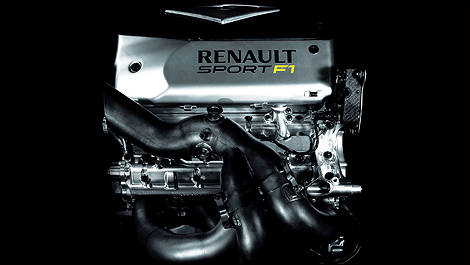 |
| (Photo: Renault Sport F1) |
The new motor is so complex that Renault does not call it an engine, but a power unit. The following information has been published by Renault Sport F1.
The new regulations that the FIA is due to introduce in 2014 will see Formula 1 enter a new era. The objective of this major change is to ensure closer ties between the research and development carried out
in F1, the concerns of everyday motorists and the new challenges faced on economic and environmental fronts, without detracting from the quality of the show or the level of competition.
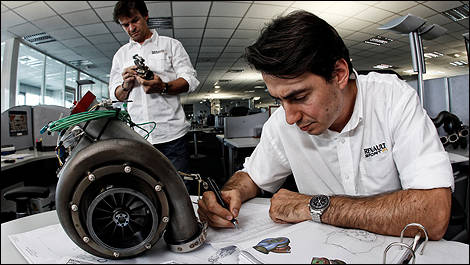 |
| (Photo: Renault Sport F1) |
This major technological revolution is a fresh challenge for Renault Sport F1’s experts, who are developing a brand new electrified 1.6-litre V6 turbo powerplant (known as a ‘power unit’), which combines a significantly downsized internal combustion engine with an energy recovery system that feeds two electric motors.
A significant reduction in fuel consumption
For 2014, the objective is to reduce the quantity of fuel needed for a Grand Prix by almost 40 percent, yet still maintain the same level of performance and power outputs (i.e. around 750 horsepower) as today.
- Switch from a V8 to a V6 architecture;
- Cubic capacity reduced by one-third from 2.4
to 1.6 litre;
- Turbocharging (single-stage compressor), plus
engine torque capped at 15,000rpm for a power
output of approximately 550 horsepower.
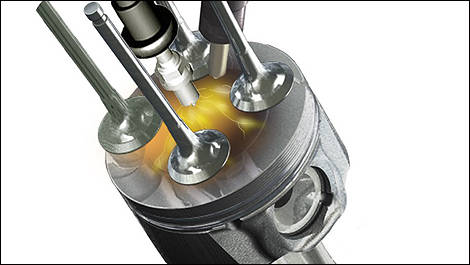 |
| Direct fuel injection. (Photo: Renault Sport F1) |
The amount of fuel that can be used during races has been reduced : the maximum quantity of fuel that may be carried by the car during a race will be reduced to 140 litres. Energy management will become a major factor of race strategies. Additionally, the maximum fuel flow rate will be reduced to 140 litres/hour, making optimisation of every drop of fuel vital for cars to go as fast as possible on a given quantity of fuel.
Development costs have been limited and the number of engines each driver can use in the course of the season has been further capped: five per driver in 2014, then four per driver from 2015 (compared to eight per driver at the moment). The technologies and materials employed must be similar to those used for production engines.
Using lost energy
The efficiency of a conventional internal combustion engine is approximately between 25 and 30 percent in optimal conditions of use. This means that 70 percent of the energy provided by the fuel combustion is lost in the form of heat, either via the car's radiators (exchange of heat between the engine block and the cooling fluids) or, more significantly, via the exhaust gases.
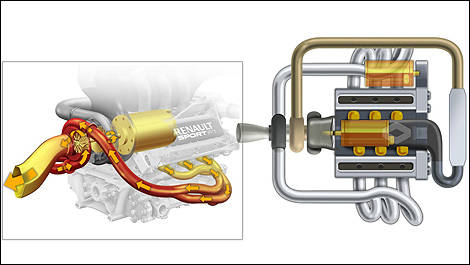 |
| (Photo: Renault Sport F1) |
ERS-H (Energy Recovery System - Heat)
The considerable energy contained in exhaust gases as they exit an engine equates to almost 55 percent of the energy provided by the fuel. This is a huge loss. In the case of the 2014 power unit, however, the motor-generator unit (MGU-H) mounted on the turbo will permit a proportion of this otherwise wasted thermal energy (eliminated via a 'waste gate') to be recovered and converted into electricity.
This electricity is then stored in the battery or used by the other motor-generator unit (MGU-K) to drive the car. This system will allow the MGU-K to be used for practically an entire lap. This system is known as ERS-H (Energy Recovery System - Heat).
A second valuable function of it is to drive the turbo after a period of braking, thereby avoiding the phenomenon of lag (which can last several seconds) before the torque 'requested' by the driver is delivered by the V6 engine.
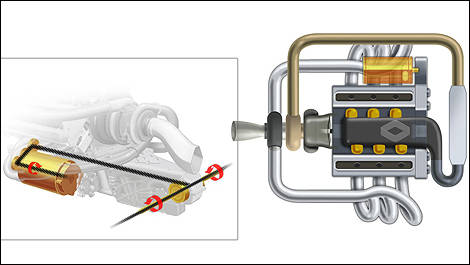 |
| (Photo: Renault Sport F1) |
ERS-K (Energy Recovery System - Kinetic)
Under braking, the kinetic energy of a racecar is dissipated by the brakes in the form of heat. The regulations allow a proportion of this energy to be transformed into electricity via the MGU-K motorgenerator unit connected to the crankshaft of the internal combustion engine.
This motor-generator unit will be capable of recovering 2MJ (Mega Joules) and delivering 4MJ per lap, which equates to a use for approximately 34 seconds per lap (as opposed to 6.5s/lap in the case of today's KERS). The MGU-K will be capable of delivering peak power of 120 kilowatts (more than 160 horsepower). This system is known as ERS-K (Energy Recovery System - Kinetic).
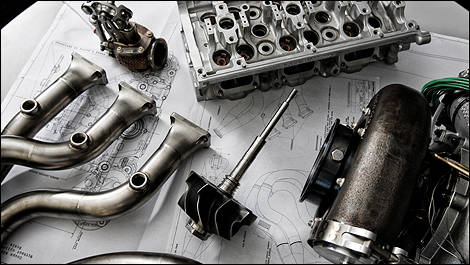 |
| (Photo: Renault Sport F1) |


